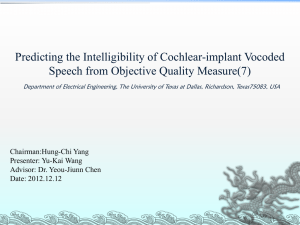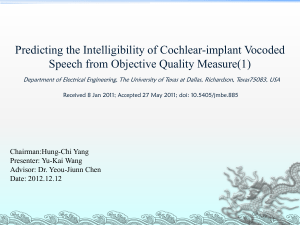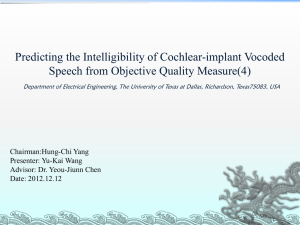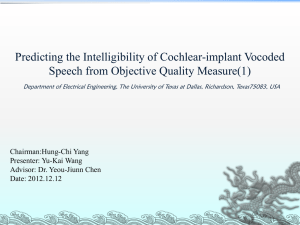Predicting the Intelligibility of Cochlear-implant Vocoded Speech from Objective Quality Measure(2)
advertisement
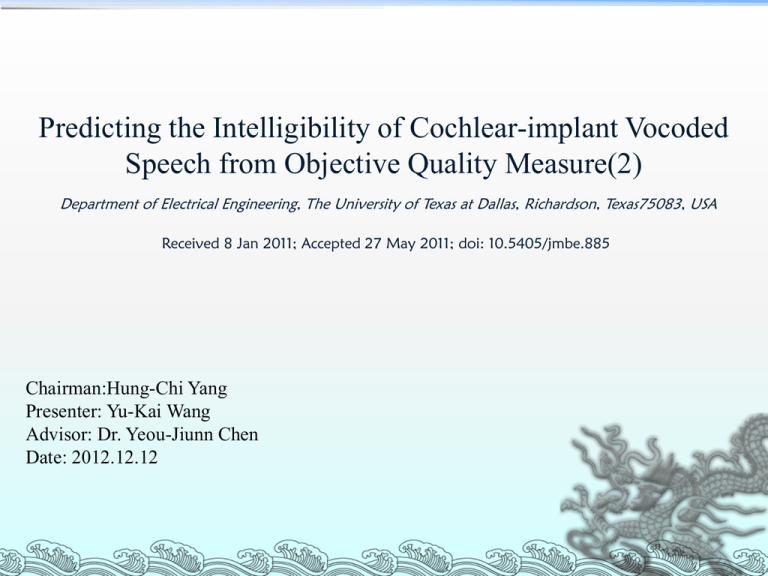
Predicting the Intelligibility of Cochlear-implant Vocoded Speech from Objective Quality Measure(2) Department of Electrical Engineering, The University of Texas at Dallas, Richardson, Texas75083, USA Received 8 Jan 2011; Accepted 27 May 2011; doi: 10.5405/jmbe.885 Chairman:Hung-Chi Yang Presenter: Yu-Kai Wang Advisor: Dr. Yeou-Jiunn Chen Date: 2012.12.12 Outline Material and Methods Results Conclusions Material and Methods 2.4 Procedure Environment In a sound-proof room,using a PC connected to a TuckerDavis System 3 workstation. Stimuli were played to listeners monaurally through A Sennheiser HD 250 Linear II circumaural headphone at a comfortable listening level. Material and Methods Conditions Participated in a 10-minute training and session(Prior to the test). Listened to a set of tone-vocoded and EAS-vocoded stimuli to familiarize. Subjects were asked to write down all thewords they had heard. Material and Methods Experiments Experiments 1 and 2 listened to vocoded English stimuli Experiment 3 listened to vocoded Mandarin Chinese stimuli Total of 30 and 24 test conditions,respectively total of 20 test conditions,respectively Twenty sentences, and none of the sentences were repeated. The order of the test conditions was randomized. Subjects were given a 5-minute break every 30 minutes during the testing session.. Material and Methods Used objective speech quality measures for predicting the intelligibility of vocoded speech in noisy conditions. Vocoded English Vocoded Mandarin Chinesein This study investigated the performance. The linear predictive coding (LPC) The log-likelihood ratio (LLR) The Itakura-Saito (IS) The cepstrum (CEP) distance measures Material and Methods Evaluated the performance of the time-domain segmental . SNR measure (SNRseg) The frequency-weighted SNR measure (fwSNRseg) The weighted spectral slope (WSS) measure The above measures are primarily based on. The premise that speech quality can be modeled in terms of differences in loudness between the original and processed signals. In terms of differences in the spectral envelopes. (e.g., as computed using an LPC model) between the original and processed signals. Material and Methods The PESQ measure. Assesses speech quality by estimating the overall loudness difference between the noise-free and processed signals. Results Two statistical measures were used to assess the performance of the tested speech quality measures. The average intelligibility scores obtained . Pearson’s correlation coefficient (r) An estimate of the standard deviation of the prediction error. NH listeners were subjected to correlation analysis with the corresponding values. The objective measures Scores obtained for a total of 54 and 20 test conditions were included in the correlation analysis . (Shown in Table 1) Vocoded English. Vocoded Mandarin Chinese. Results Figure 1 shows sentence intelligibility scores 54 vocoded test conditions of English sentences . 20 vocoded test conditions of Mandarin Chinese sentences. Results Table 3 shows. The resulting correlation coefficients and predictions errors Vocoded English The PESQ measure had the highest correlation (r = 0.91) (see scatter plot in Fig. 1(a)). vocoded Mandarin Chinese Confirms the results of Chen and Loizou The other conventional objective measures (IS, SNRseg, and fwSNRseg) was good (r = 0.63~0.69). The LLR, CEP, and WSS measures was quite poor (r = -0.48~0.57). Results See scatter plot in Fig. 1(b) The PESQ measure The WSS measure A very low correlation (r = 0.48) A high intelligibility prediction with a correlation of (r = -0.87) The other conventional objective measures Poorly predicted the intelligibility of vocoded Mandarin Chinese (r = -0.40~0.42). Results Table 3 also shows the correlation coefficients EAS-vocoder (EAS in the table)). The PESQ measure consistently well predicts the intelligibility of both tone-vocoded (r = 0.92) EAS-vocoded (r = 0.90) English sentences. The WSS measure yielded a high correlation with the intelligibility of tone-vocoded English sentences (r = -0.85). This might be due to the relatively small number of tone-vocoder conditions Results The WSS measure was highly correlated with the intelligibility of Mandarin Chinese sentences When processed by tone-vocoder(r = -0.90) and EAS-vocoder (r = -0.92). Results Conclusion Assessed the performance of several objective measures of predicting the intelligibility of vocoded speech. PESQ, highly correlated with the intelligibility score. Most objective measures performed modestly well or poorly in predicting the intelligibility of vocoded speech. The language effect was found to have an impact on the performance of predicting the intelligibility of vocoded speech.
